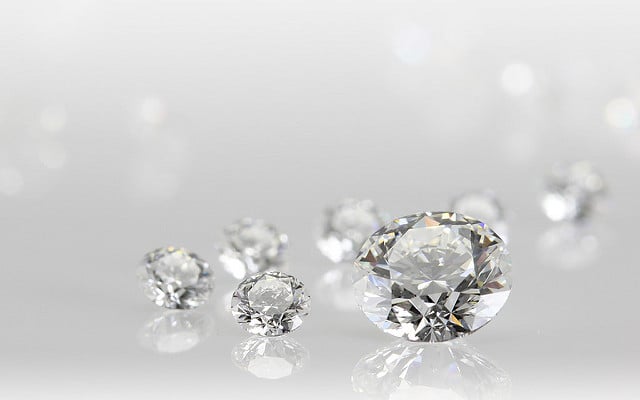Evaluating Diamond Cuts: The Hanneman Diamond Cut Grading System, Lesson Four
The Hanneman System makes evaluating diamond cuts easier. You can use total height and C/P ratios to cut grade round brilliants without subjective terms.
3 Minute Read
Evaluating Diamond Cuts by C/P Ratio
Since we've already disposed of Junk and Garbage grade diamonds in Lesson Three, we must now define the remaining categories. We have Good, Better, and Best. To begin, we need to determine the C/P ratio. Simply divide the value of the crown angle of the stone by the value of its pavilion angle. You should get a result somewhere between 0.79 and 0.91. If you don't, you've made an arithmetic mistake.
Now, consult the table below to convert that C/P value into the cut category of your stone. That's all there is to it.
| C/P Ratio | Cut Category |
| 0.83 - 0.85 | Best |
| 0.81 - 0.83 or 0.85 - 0.88 | Better |
| 0.79 - 0.81 or 0.88 - 0.91 | Good |
| Less than 0.79 or More than 0.91 | Junk or Garbage |
If you were to go back and measure the stones you previously classified as Junk or Garbage on the basis of total height, many would indeed show C/P ratios between 0.79 and 0.91. Don't do that. It will only confuse you. You've already eliminated them from consideration. Remember, the stones you're measuring now have already passed the total height test. Merely having the "correct" C/P ratio isn't enough.
The Problem and Solution to Evaluating Diamond Cuts
Obviously, as illustrated above, you can convert any total height and C/P ratio into a cut grade. The grades above represent perhaps the most stringent cut grading system yet devised. As previously demonstrated, it's more stringent than the present GIA system or any other system in general use today.
Therein lies the problem. A cut rating of "Good" doesn't have an unambiguous definition clearly understood by everyone everywhere. Simply put, that term is subjective and, therefore, useless. Time and experience have shown that no simple way of resolving that problem exists.
The only solution lies in abandoning the use of subjective terms and replacing them with purely objective numbers. This can and should be done for all future cut grading reports. Simply reporting the total height as % of diameter and the C/P value of a stone will accomplish this.
With that information, anyone can cut grade any stone without ever seeing it, as I've shown. Reporting these two values wouldn't require any change in present practices. Graders could still use their subjective terms, thus keeping customers confused. They would still wonder why one grader calls their stone's cut "Excellent" while another calls it only "Very Good." However, now anyone can also simply look at the total height and C/P ratio values. They would instantly recognize that both graders evaluated that stone identically. Customers would understand that only the subjective categories the graders used to describe the cut differed.
Advantages of Reporting C/P Ratios
Current cut grading systems measure the crown and pavilion angles to the nearest 0.1 degree. Since the C/P value is a ratio, calculating that value to three decimal places poses no problem.
Now, suppose a laboratory arbitrarily chose to define their "Very Good" category as having the "correct" total height and a C/P ratio of 0.800 to 0.820. Let's say they receive two stones, which have C/P ratios of 0.801 and 0.819, respectively. Of course, the lab could simply report both stones as grading "Very Good." However, that's not the whole story.
The first stone is what one could call "barely Very Good," while the other could be described as "almost Excellent." All other things being equal (which they never are), there should be some sort of a value differential between the two stones. If so, I believe it would behoove the laboratory to convey that information about the two stones to their customer. Using C/P ratios, the graders can do this easily. In the present system, however, it's impossible. Essentially, reporting C/P ratios can increase the precision of your cut grade by an order of magnitude. That's, indeed, worth doing.
Epilogue
If you doubt the superiority of this system, I invite you to try it on your own previously graded stones. Besides the simplicity and ease of determining the final cut grade, you'll find the results (adjusted for the less stringent requirements of your present system) essentially identical. As I said at the beginning: "This information can also be used to evaluate the relative severity of any commercial grading system or laboratory. Simply plug in their numbers and compare the results."
The Hanneman Diamond Cut Grading System Series
- Introduction, Lesson One
- Basic Proportions, Lesson Two
- Grading Categories, Lesson Three
- Evaluating the Cut, Lesson Four
William Hanneman
W. William Hanneman, Ph.D. is a retired research analytical chemist. Gemology is his hobby. He has authored several books, guides, and toolsets based on his unique chemistry based perspective on gemology.
Related Articles
Cut Diamond Grade Categories: The Hanneman Diamond Cut Grading System, Lesson Three
Exposing Diamond Overgrading at EGL Labs
How to Grade Set Gemstones
Rubellite Tourmaline Buying Guide
Latest Articles
800 Years of Mogok: A Celebration in Tenuous Times
What is the Average Gemstone Faceting Yield?
Pyroxmangite Value, Price, and Jewelry Information
How to Identify Emerald Simulants and Synthetics
Never Stop Learning
When you join the IGS community, you get trusted diamond & gemstone information when you need it.
Get Gemology Insights
Get started with the International Gem Society’s free guide to gemstone identification. Join our weekly newsletter & get a free copy of the Gem ID Checklist!
